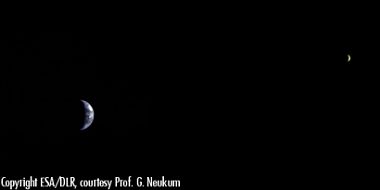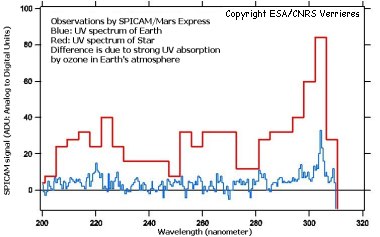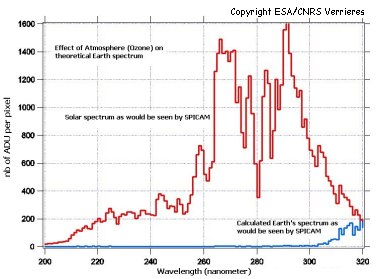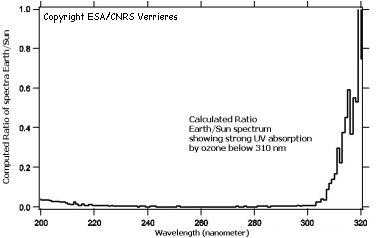Mars Express Analyses the Earth
HRSC Images the Earth and Moon
In the night of 3 July, the ESA Mars Express spacecraft was pointed backwards to obtain a view of the Earth/Moon system from a distance of 8 million km while on its way to Mars. Most of the payload onboard the spacecraft was successfully switched on to perform first measurements and to verify their proper function.
 |
|
The Earth/Moon system, captured by HRSC |
This unique view of the terrestrial and lunar crescents was taken by the High Resolution Stereo Camera (HRSC) in combination with its Super Resolution Channel SRC. It shows the Pacific Ocean in blue and clouds in white to light grey near the equator and mid- to northern latitudes. At the distance of 8 million km, the SRC obtained 10 black-and-white images with a pixel resolution of 75 km of the Earth and subsequently 10 images of the Moon with the MEX spacecraft pointing first towards the blue planet and then towards the Moon being 0.9° apart. The angle between MEX, Earth and the Sun was 70°. Color images where obtained by the HRSC at a roughly five-times lower spatial resolution and in the three colors blue, green and near-infrared while the MEX spacecraft performed a continuous slew motion from the Earth towards the Moon in order to enable an image scan of the entire system. The Earth image is 180 pixels across from top to bottom. The pictures and the information content of the data show that instrument health is good and function nominal. The operations sequence by ESOC for image taking was perfect. The operations of the experiment were supported by the DLR experiment operations team.
A number of image processing steps was necessary to combine the high-resolution SRC images with the lower-resolution HRSC color data including radiometric and geometric corrections, contrast enhancement, image matching and artefact removal in order to produce a near-true color image..
The German High Resolution Stereo Camera experiment is led by the Principal Investigator Prof. Dr. G. Neukum (Freie Universität Berlin). Image processing was performed by DLR Berlin, Institute of Planetary Research.
The HRSC experiment onboard ESA's Mars Express mission combines a stereo and color multi-line scanner with 5000 pixels each, taking nearly simultaneously 9 image scans at high resolution, triple stereo, four colors and five different viewing angles, with a "super-resolution" framing camera channel which on a field of 1000 x 1000 pixels gives black-and-white images of about five-times higher resolution compared to the HRSC proper.
This image is the first picture of planetary objects of the camera on its way to Mars. Although the spatial resolution is low at this great distance from the Earth/Moon-system, the picture gives a good first-order impression of what to expect for the MEX mission in its orbit around Mars at pericenter altitudes of only 250 km - 300 km: very high resolution of up to 2 m and images in brilliant color and impressive stereo for most of the surface of Mars. This will tremendously increase our understanding of the Mars surface morphology and topography, of the geologic structures, the processes which were active in the past and present and eventually of its geologic evolution including the important question of how much water there was and whether Mars had conditions even for the evolution of life. HRSC will produce a unique data set for scientific analyses in the fields of geoscience, photogrammetry/cartography, spectrophotometry, and atmospheric science, which will be performed during the mission by an international team of 45 Co-Investigators together with their associates from 30 institutes and 10 countries. Six months after receipt, the data will be released to the scientific community at large for further analyses probably for many years to come.
OMEGA Spectral Analysis
July 3, 2003, OMEGA acquired spectra of the Earth and its Moon.
From the 8 millions of km distance, the Earth filled about one OMEGA pixel. Thus, the spectrum corresponds to the entire illuminated crescent, dominated by the Pacific Ocean. The spectrum covers the visible and near-infrared spectral domain, from 0.35 to 5.15 µm, with a spectral sampling varying from 4 to 20 nm.
|
First OMEGA spectrum of the Earth |
These Earth observations by OMEGA, in the 0.35-5.15 micron range, have several unique features, of interest for a variety of scientists. The NASA/Galileo mission observed the Earth during two encounters in 1990 and 1992, and some interesting observations were reported from the NIMS IR investigation, but without the possibility of observing the global spectrum, due to saturation effects on the instrument, not designed for observing too bright objects. For OMEGA, small integration times have been purposely chosen. In addition, the global disk of the Earth was observed at high phase angle, contrary to usual low orbit observation. Such global disk spectra are useful to prepare future observations of Earth-like planets, as for the Darwin mission.
|
Major species features in the 1-2.5 µm range |
Major species features in the 2.5-5.1 µm range |
SPICAM Detects Ozone
SPICAM/Mars Express detects strong quantities of ozone in the atmosphere of the Earth, allowing life on this planet.
On July, 3, 2003, a spectrum of Earth illuminated by solar light was recorded by the Ultra-Violet spectrometer SPICAM, on board Mars Express. Taken from a distance of 7 million km, the spectrum shows only some signal at 310 nanometers, and nothing at shorter wavelengths, though the instrument sees plenty of UV light from another star. This is what is expected if the atmosphere of the Earth contains ozone, a gaseous species made of 3 atoms of oxygen, known to provide a natural screen to harmful UV solar radiation.
"Together with the OMEGA infrared spectrometer detection of water vapour and oxygen, the detection of copious amounts of ozone in the atmosphere indicates that this planet that we call Earth could sustain life", says Jean-Loup Bertaux, a French CNRS scientist from Service d'Aéronomie/IPSL, responsible for the SPICAM instrument.
The main scientific objective of SPICAM is to observe both ozone and water vapour in the atmosphere of Mars. But the quantity of ozone on Mars is about 100 times smaller than on Earth, and solar UV radiation reaches the ground of Mars with little attenuation only, making life difficult to persist at the surface of Mars under present conditions.
 |
|
Blue line: The spectrum (intensity of light as a function of wavelength) of the Earth recorded by SPICAM in the Ultra-violet. This light comes from solar light scattered by the atmosphere of the Earth back to outer space. Only the peak just above 300 nm is significantly above noise. |
The interpretation of SPICAM spectrum is completely supported by simulations of the effect of the atmosphere on the solar radiation which is scattered by the Earth (with MODTRAN software). Ozone absorbs all solar radiation between 200 and 300 nm, preventing harmful effects on the DNA molecules of all living species exposed to the Sun.
 |
|
Red line: Simulation of the solar light scattered by the atmosphere that would be seen by SPICAM if there were no atmospheric absorption. Blue line: simulation with a realistic Earth atmosphere containing ozone. The difference between the two spectra is due to the presence of the ozone layer in the upper atmosphere of the Earth. |
 |
|
This curve represents the attenuation factor (below unity) of the scattered solar radiation by ozone in the atmosphere of the Earth. It's obtained from the ratio of the two curves in the previous figure. |
Credits: SPICAM is a dual UV-near IR spectrometer , designed and built by Service d'Aéronomie (France, BIRA (Belgium), and IKI Space Research Institute (Russia), under the leadership of Jean-Loup Bertaux, Paul Simon and Oleg Korablev.
Further questions may be channelled to: bertaux aerov.jussieu.fr
aerov.jussieu.fr

